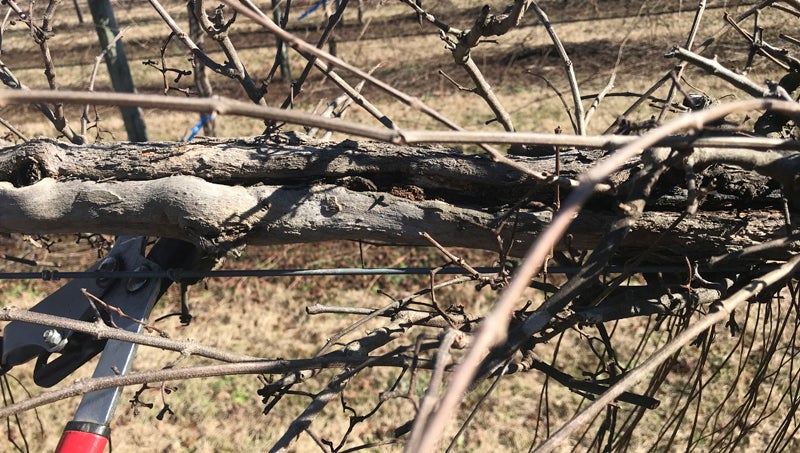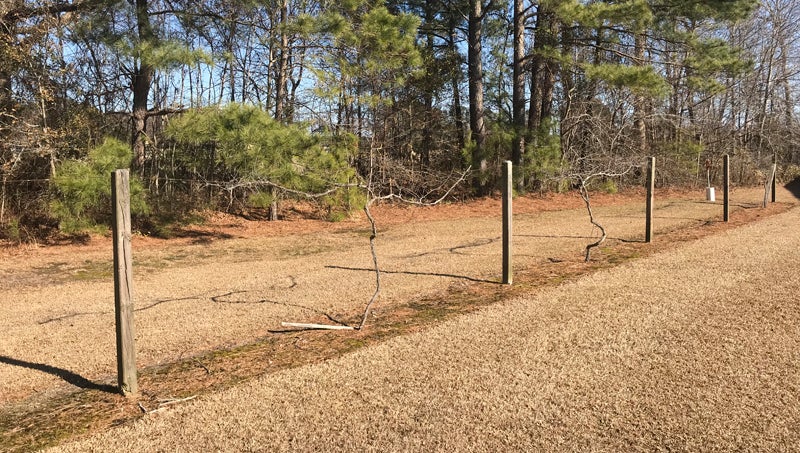How do I prune my Scuppernong grapes?
Published 7:27 pm Thursday, January 31, 2019

- CRACKED UP: Damage from the cold can cause cordons to crack, as pictured here. (Gene Fox)
This is one of the more frequent questions that I receive this time of year. However, before I get into how to prune these grapes, I feel a little education is in order.
First and foremost, in the instance that you are ever on a quiz show asking questions about grapes, Scuppernong is a variety (typically, a generic name used for all white grape cultivars) of muscadine grape. The Scuppernong variety was selected from the wild in Tyrrell County by Isaac Alexander around 1760. Most homeowners have a cultivar of muscadine grapes growing in their home grounds. Table grapes, also called vinifera grapes, do not grow well in eastern North Carolina because of susceptibility to Pierce’s disease.
Muscadines are nearly bullet-proof vines that grow well in a variety of conditions. The grapes themselves are much different than table grapes in that they have a tougher skin or hull that most folks do not care to eat (and to my knowledge there is only one seedless cultivar). However, this makes them fun to eat for kids! Take the grape in your mouth and apply enough pressure to pop the hull open to reveal an amazingly sweet fruit. Spit the hull and seed out like a watermelon seed and on to the next grape. In my opinion, the muscadine should be celebrated not only for being fun to eat, but for its long list of health benefits.
We have many cultivars of muscadines that work well in eastern North Carolina. To name a few:
- Carlos: a white grape that is used in winemaking and is often found in homeowner production
- Noble: the primary red grape that is used in muscadine winemaking and juice production
- Fry: a white grape that is good for fresh market production
- Nesbitt: a large black grape that ripens over a three-week period, good for the fresh market
- Supreme: a very large black grape, that reaches the size of a small plum, with edible skin
- Triumph: a large, bronze grape that is good fresh
There are several more that can be recommended for homeowners to grow in their landscapes. Some cultivars are self-fertile but others require pollination, so be sure to research your cultivar before planting. Visit grapes.ces.ncsu.edu for more information on cultivars. You can also search for wild muscadine grapes found on the edge between cleared and wooded land. It is important to know what you are searching for when gathering any plant in the wild! Remember, there is unrelenting competition for wild fruit from raccoons and other wildlife, so count yourself blessed to find many ripe, wild grapes.
Before we can get into pruning, it is important to discuss training. All fruit, with very few exceptions (paw-paw being the only one that I can think of), need full sunshine to develop their fruit. The University recommendation for muscadines is to use a single trellis system for maximum production and ease of pruning. Information on trellis, materials and training can be found at your local Extension office. If you have a vine trained to an arbor, don’t fret, this is okay too! To prune these vines however, it requires a lot of extra work to ensure the vines don’t shade themselves out. If the vines shade themselves out, there will be very little to harvest.

WINTER PRUNING: The first step in Scuppernong pruning is to use hedge trimmers to trim vines back to a level in which you can see what to prune. (Gene Fox)
Now that we have that out of the way, let’s talk pruning! The cultivar and its vigor will determine how to prune the vine. A more vigorous vine can handle leaving more buds where as a less-vigorous vine will leave fewer buds per foot after pruning. Looking at the vine, we have four parts we will work on. There is the trunk that should be inspected for borers or any damage. There are the cordons, these are the main leaders on the vine that will be trained to our trellis system. On the cordons there will be spurs. Healthy spurs produce new wood each year that will bear next year’s fruit.
The first step to winter/dormant pruning is to use hedge trimmers to trim the vines back to a level in which you can see what to prune. Hedge trimmers should be used before harvest to make it easier to find and harvest fruit as well. Next, inspect the vines for any cold damage (pictured), this will look like large cracks and cause rotten spots in the cordons. Take a good look at the spurs and make certain that they are healthy and thriving. Using hand-pruners, cut out any new wood that is less than a pencil-diameter in size. Now, trim the remaining new wood back to allow for 10-20 buds per linear foot of the cordon. This is accomplished by leaving 2-4 buds per healthy spur.
If you have questions about how to prune your vine, call the Extension Master Gardener volunteers in Beaufort County or Gene Fox at 252-946-0111.
If you are having an issue in your home garden or landscape, send your questions to Gene Fox, please email at Gene at gene_fox@ncsu.edu. You might just make the paper!
Gene Fox is a consumer horticulture agent with the North Carolina Cooperative Extension Service, covering Beaufort, Hyde, Tyrrell and Washington counties.




